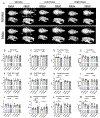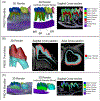Infigratinib, a selective FGFR1-3 tyrosine kinase inhibitor, alters dentoalveolar development at high doses
- PMID: 37435833
- PMCID: PMC10784415
- DOI: 10.1002/dvdy.642
Infigratinib, a selective FGFR1-3 tyrosine kinase inhibitor, alters dentoalveolar development at high doses
Abstract
Background: Fibroblast growth factor receptor-3 (FGFR3) gain-of-function mutations are linked to achondroplasia. Infigratinib, a FGFR1-3 tyrosine kinase inhibitor, improves skeletal growth in an achondroplasia mouse model. FGFs and their receptors have critical roles in developing teeth, yet effects of infigratinib on tooth development have not been assessed. Dentoalveolar and craniofacial phenotype of Wistar rats dosed with low (0.1 mg/kg) and high (1.0 mg/kg) dose infigratinib were evaluated using micro-computed tomography, histology, and immunohistochemistry.
Results: Mandibular third molars were reduced in size and exhibited aberrant crown and root morphology in 100% of female rats and 80% of male rats at high doses. FGFR3 and FGF18 immunolocalization and extracellular matrix protein expression were unaffected, but cathepsin K (CTSK) was altered by infigratinib. Cranial vault bones exhibited alterations in dimension, volume, and density that were more pronounced in females. In both sexes, interfrontal sutures were significantly more patent with high dose vs vehicle.
Conclusions: High dose infigratinib administered to rats during early stages affects dental and craniofacial development. Changes in CTSK from infigratinib in female rats suggest FGFR roles in bone homeostasis. While dental and craniofacial disruptions are not expected at therapeutic doses, our findings confirm the importance of dental monitoring in clinical studies.
Keywords: bone; fibroblast growth factor receptor; mineralized tissue/development; tooth development.
© 2023 American Association for Anatomy.
Figures







Similar articles
-
Infigratinib in children with achondroplasia: the PROPEL and PROPEL 2 studies.Ther Adv Musculoskelet Dis. 2022 Mar 21;14:1759720X221084848. doi: 10.1177/1759720X221084848. eCollection 2022. Ther Adv Musculoskelet Dis. 2022. PMID: 35342457 Free PMC article.
-
Low-dose infigratinib increases bone growth and corrects growth plate abnormalities in an achondroplasia mouse model.J Bone Miner Res. 2024 Jul 23;39(6):765-774. doi: 10.1093/jbmr/zjae051. J Bone Miner Res. 2024. PMID: 38590263
-
Achondroplasia: aligning mouse model with human clinical studies shows crucial importance of immediate postnatal start of the therapy.J Bone Miner Res. 2024 Nov 29;39(12):1783-1792. doi: 10.1093/jbmr/zjae173. J Bone Miner Res. 2024. PMID: 39423254 Free PMC article.
-
Fibroblast growth factor receptor-3 as a therapeutic target for Achondroplasia--genetic short limbed dwarfism.Curr Drug Targets. 2003 Jul;4(5):353-65. doi: 10.2174/1389450033490993. Curr Drug Targets. 2003. PMID: 12816345 Review.
-
FGFR inhibitors: Effects on cancer cells, tumor microenvironment and whole-body homeostasis (Review).Int J Mol Med. 2016 Jul;38(1):3-15. doi: 10.3892/ijmm.2016.2620. Epub 2016 May 31. Int J Mol Med. 2016. PMID: 27245147 Free PMC article. Review.
References
-
- Legare JM. Achondroplasia. In: Adam MP, Ardinger HH, Pagon RA, et al., eds. GeneReviews®. University of Washington, Seattle; 1993. Accessed March 1, 2022. http://www.ncbi.nlm.nih.gov/books/NBK1152/ - PubMed
Publication types
MeSH terms
Substances
Grants and funding
LinkOut - more resources
Full Text Sources
Miscellaneous

